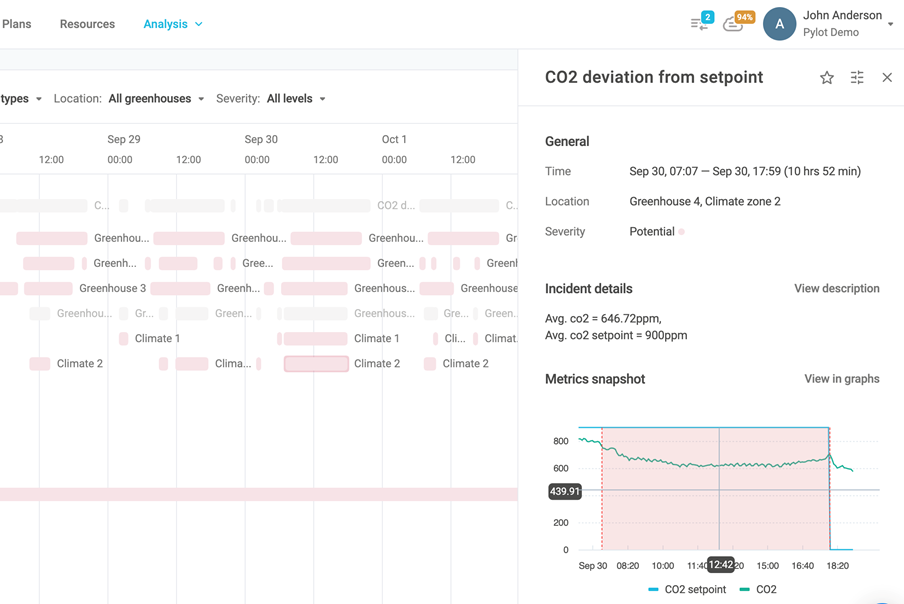We are excited to announce some improvements in the Climate Incidents functionality of the PYLOT Greenhouse Data Platform. These updates aim to enhance the monitoring and management of greenhouse conditions, providing growers with valuable insights and tools to optimize their operations.

Further improvement of Climate Incidents
Make your growing easier with new improvements in climate incidents.
New Types of Climate Incidents
The latest release introduces several new types of climate incidents that can be detected and analyzed by the PYLOT algorithms. These incidents are categorized based on their impact on plant health and overall greenhouse performance. Let's take a closer look at some of these new incident types:
- CO2 deviation from setpoint: The main focuses of this type are 1) To analyse the deviation of CO2 concentration from the setpoint of the climate computer (in the current version a deviation of 130ppm is allowed and can be adjusted according to the requirements of the greenhouse); 2) To check the calibration of the sensor at night, when there is no setpoint and no sunlight (or artificial light), taking into account the fact that the CO2 concentration cannot be below the natural level; 3) To provide an analysis of the maximum CO2 concentration to prevent overdose with parasitic gases (the current version is 1400ppm and can also be adjusted to any value).
- Heating and venting setpoints conflict: Sometimes growers set the heating system setpoint higher than the ventilation system setpoint. The temperature in the heating circuits rises and the vent windows open, all at the same time. Convection in the greenhouse increases, which causes a loss of humidity, CO2 concentration and heat. On the one hand, this is a great way to reduce humidity in the greenhouse, and on the other hand it might be a seemingly small mistake that could lead to negative consequences and disrupt climatic conditions for plants, as well as lead to unnecessary energy costs. Our algorithms analyse the possibility of conflict between heating and ventilation subsystems and, in the case when the temperature is below the heating setpoint or there is no need to reduce humidity, notifies about an abnormal conflict between subsystems, which most often occurs due to human error, when it is difficult to consider all possible settings of influences on different subsystems.
Enhanced Incident Information
To provide a comprehensive understanding of climate incidents, PYLOT now offers enhanced incident information. This includes the ability to capture snapshots with essential details, such as duration, location, and severity of the incident. By visualizing the incident through a snapshot displaying the necessary climate parameters, growers can spend much less time for analysis and together with timeline easily detect common problems (patterns) for different incidents.
Climate Incidents For Each Climate Zone
PYLOT understands that different climate zones require specific attention and analysis. With this in mind, the platform's algorithms analyze climate parameters separately for each climate zone and generate incidents accordingly. This ensures that growers receive accurate and relevant information tailored to their specific compartment and growing conditions.
These updates in the Climate Incidents feature of the PYLOT Greenhouse Data Platform demonstrate our commitment to providing advanced tools and insights to support growers in optimizing their greenhouse operations. By effectively monitoring and managing climate incidents, growers can proactively address issues, minimize risks, and maximize the productivity and health of their crops.
Stay tuned for more updates and innovations from PYLOT as we continue to empower growers with data-driven solutions for sustainable and efficient greenhouse cultivation.

Contact one of our specialists
Fill in your contact details and questions or remarks. We will contact you soon!